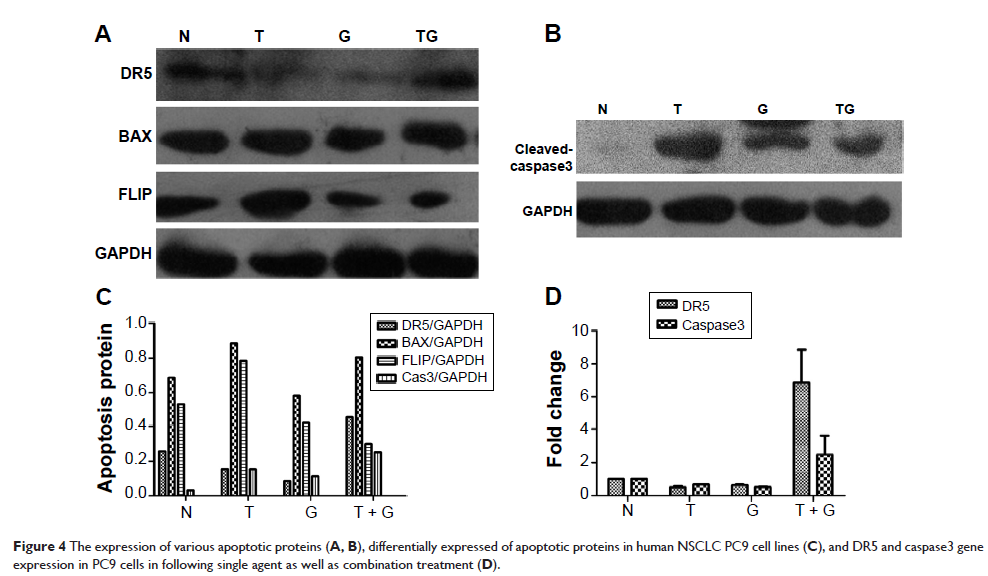100417
论文已发表
注册即可获取德孚的最新动态
IF 收录期刊
- 3.3 Breast Cancer (Dove Med Press)
- 3.4 Clin Epidemiol
- 2.5 Cancer Manag Res
- 2.9 Infect Drug Resist
- 3.5 Clin Interv Aging
- 4.7 Drug Des Dev Ther
- 2.7 Int J Chronic Obstr
- 6.6 Int J Nanomed
- 2.5 Int J Women's Health
- 2.5 Neuropsych Dis Treat
- 2.7 OncoTargets Ther
- 2.0 Patient Prefer Adher
- 2.3 Ther Clin Risk Manag
- 2.5 J Pain Res
- 2.8 Diabet Metab Synd Ob
- 2.8 Psychol Res Behav Ma
- 3.0 Nat Sci Sleep
- 1.8 Pharmgenomics Pers Med
- 2.7 Risk Manag Healthc Policy
- 4.2 J Inflamm Res
- 2.1 Int J Gen Med
- 4.2 J Hepatocell Carcinoma
- 3.7 J Asthma Allergy
- 1.9 Clin Cosmet Investig Dermatol
- 2.7 J Multidiscip Healthc

已发表论文
针对非小细胞肺癌 (NSCLC) 中对吉非替尼 (Gefitinib) 敏感的细胞系,吉非替尼通过上调死亡受体 5 的表达来介导由 rmhTRAIL 诱导的细胞凋亡
Authors Yan D, Ge Y, Deng H, Chen W, An G
Published Date July 2015 Volume 2015:8 Pages 1603—1610
DOI http://dx.doi.org/10.2147/OTT.S73731
Received 4 September 2014, Accepted 4 May 2015, Published 3 July 2015
Approved for publication by Professor Jianmin Xu
Background: Tumor necrosis factor-related apoptosis-inducing ligand (TRAIL) triggers apoptosis in tumor cells, but when used alone, it is not effective in the treatment of TRAIL-resistant tumors. Some studies have shown that gefitinib interacts with recombinant mutant human TRAIL (rmhTRAIL) to induce high levels of apoptosis in gefitinib-responsive bladder cancer cell lines; however, the molecular mechanisms underlying the anticancer effects are not fully understood. Several reports have shown that the death receptor 5 (DR5) plays an important role in sensitizing cancer cells to apoptosis induced by TRAIL. Therefore, we investigated the effects of the combination of drugs and the expression of the DR5 to analyze the growth of a gefitinib-responsive non-small cell lung cancer cell line PC9, which was treated with rmhTRAIL and gefitinib individually or in combination.
Methods: Human PC9 non-small cell lung cancer cells harboring an epidermal growth factor receptor mutation were used as a model for the identification of the therapeutic effects of gefitinib alone or in combination with rmhTRAIL, and cytotoxicity was assessed by MTT assays. Cell cycle and apoptosis were investigated using flow cytometry. Moreover, the effects of drugs on DR5, BAX, FLIP, and cleaved-caspase3 proteins expressions were analyzed using Western blot analyses. Finally, quantitative polymerase chain reaction analysis was carried out to assess whether rmhTRAIL and gefitinib modulate the expression of genes related to drug activity.
Results: Gefitinib and rmhTRAIL synergistically interact to inhibit cell proliferation, and apoptosis assessment demonstrated that associations of drug increased the apoptotic index. rmhTRAIL when used alone downregulated DR5 and upregulated BAX, FLIP, and cleaved-caspase3 proteins expressions. However, results obtained in Western blot analyses demonstrated that the combined treatment-induced cell apoptosis was achieved involving upregulated DR5, cleaved-caspase3, and BAX proteins expression and downregulated FLIP protein expression. Moreover, quantitative polymerase chain reaction showed that gefitinib modulated the expression of targets related to rmhTRAIL activity.
Conclusion: These results indicate that epidermal growth factor receptor inhibitors enhance rmhTRAIL antitumor activity in the gefitinib-responsive PC9 cell line, and upregulated DR5 expression plays a critical role in activating caspase-signaling apoptotic pathway.
Keywords: gefitinib, rmhTRAIL, apoptosis, DR5
Methods: Human PC9 non-small cell lung cancer cells harboring an epidermal growth factor receptor mutation were used as a model for the identification of the therapeutic effects of gefitinib alone or in combination with rmhTRAIL, and cytotoxicity was assessed by MTT assays. Cell cycle and apoptosis were investigated using flow cytometry. Moreover, the effects of drugs on DR5, BAX, FLIP, and cleaved-caspase3 proteins expressions were analyzed using Western blot analyses. Finally, quantitative polymerase chain reaction analysis was carried out to assess whether rmhTRAIL and gefitinib modulate the expression of genes related to drug activity.
Results: Gefitinib and rmhTRAIL synergistically interact to inhibit cell proliferation, and apoptosis assessment demonstrated that associations of drug increased the apoptotic index. rmhTRAIL when used alone downregulated DR5 and upregulated BAX, FLIP, and cleaved-caspase3 proteins expressions. However, results obtained in Western blot analyses demonstrated that the combined treatment-induced cell apoptosis was achieved involving upregulated DR5, cleaved-caspase3, and BAX proteins expression and downregulated FLIP protein expression. Moreover, quantitative polymerase chain reaction showed that gefitinib modulated the expression of targets related to rmhTRAIL activity.
Conclusion: These results indicate that epidermal growth factor receptor inhibitors enhance rmhTRAIL antitumor activity in the gefitinib-responsive PC9 cell line, and upregulated DR5 expression plays a critical role in activating caspase-signaling apoptotic pathway.
Keywords: gefitinib, rmhTRAIL, apoptosis, DR5
